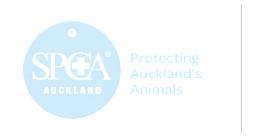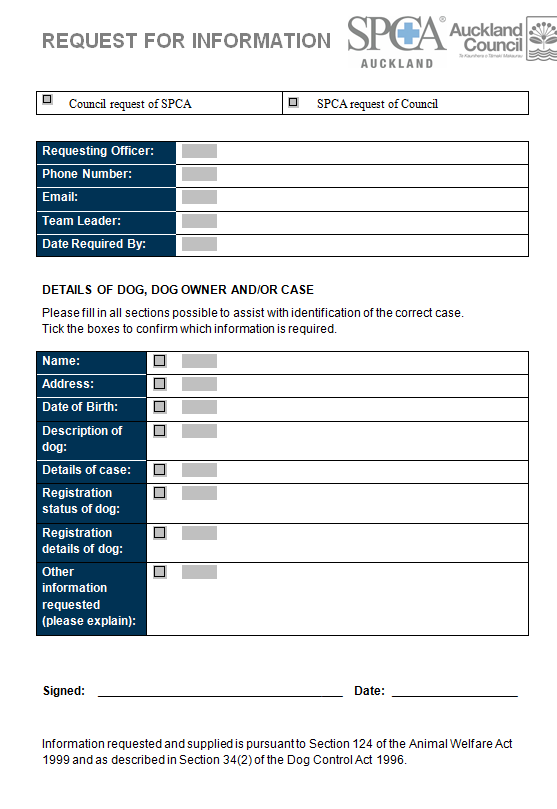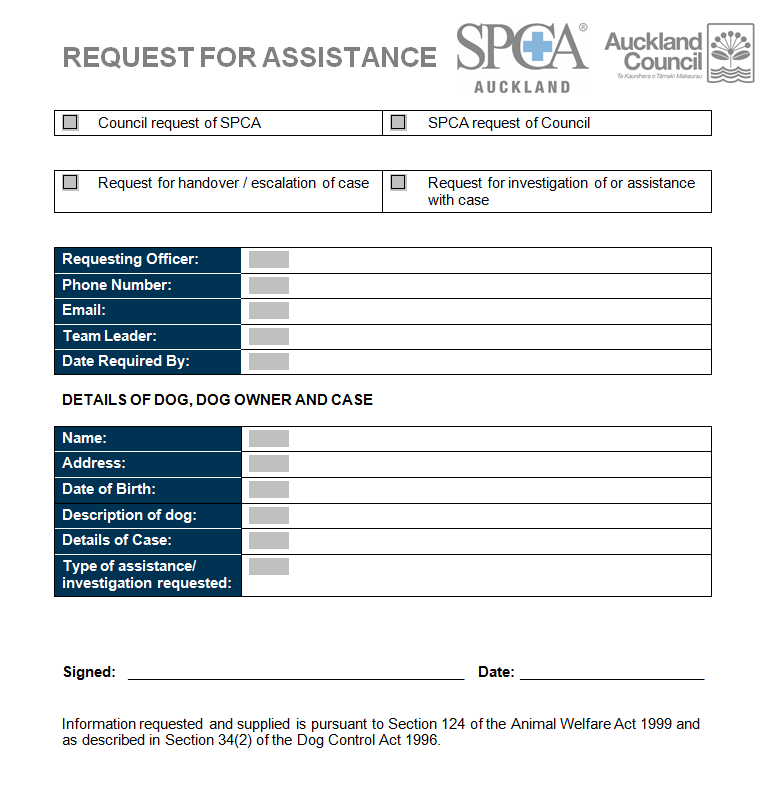
 Memorandum of Understanding (MOU)
between
Auckland Council and SPCA Auckland
Rationale/Scope
Memorandum of Understanding (MOU)
between
Auckland Council and SPCA Auckland
Rationale/Scope
SPCA Auckland (SPCA) and Auckland Council (AC) hold mutual interests in the welfare and
management of dogs within the Auckland region. With multiple areas of potential overlap of
public, legal and ethical expectations between the organisations, this agreement seeks to
ensure that each organisation can meet its core priorities and that both can work together,
where appropriate, to ensure successful outcomes.
This MOU clarifies the different roles and responsibilities of the two organisations, and
provides a framework for a positive, collaborative relationship between AC and SPCA.
Both parties agree to act in a way that will not cause damage to the reputation, operations or
goodwill of the other organisation.
This MOU is currently confined to operational activities. There is scope for future inclusion of
agreements relating to shared activities and relationships such as education, desexing or other
initiatives.
Goals and objectives
• Document high level business goals and functions of each organisation
• Identify overlaps in business functions
• Identify gaps in business functions
• Provide clear, specific roles and accountabilities for various scenarios involving dogs in
Auckland
• Provide clear, mutually agreeable messaging for public and stakeholders regarding the
roles and responsibilities, and the collaborative relationship, between the organisations
• Agree regular, timely and open channel of communication between AC and SPCA
• Develop a framework for evaluation and review of the relationship
• Ensure all dogs, especially in response to requests for service from members of the
public, are managed as efficiently as possible by the organisation most able to assist, to
ensure no unnecessary suffering of the animal, or risk to the public
• Maintain a flexible, collaborative, helpful approach to assisting the dogs of Auckland
• Support the positive reputation of both organisations
Core business drivers
Auckland Council
SPCA Auckland
• Uphold Dog Control Act 1996
• Uphold Animal Welfare Act 1999
•
•
Public safety from dogs
Reduce unwanted dogs
• Prevention of cruelty
•
•
Public nuisance from dogs
Promote and enhance
responsible pet
• Abatement of neglect
ownership
• Awareness of existence and
activities of dogs and dog
• Uphold Animal Welfare Regulations
•
owners
Education of children
and Codes of Welfare
and adults regarding pet
ownership
Roles and responsibilities
Scenario
Responsibility
Auckland Council
SPCA
Notes
Stray, healthy,
Council action if
SPCA only involved if
roaming dog
appropriate
member of public brings
directly to SPCA site
Animal injured by
Council action if
SPCA provide assistance If AMO requires
dog
necessary
where required and able
assistance for small
to
animal, to attempt to
transport to SPCA rather
than call SPCA to attend
on-site.
Dogs in AC care
AC inform SPCA via
SPCA visit animal in all
If SPCA does not consider
with evidence of
appropriate form
reasonably possible
case worth investigating,
neglect / cruelty
cases and provide report to provide written report
with reasoning
Dog trapped in
If AC receives call,
If SPCA receives call,
Council has no powers to
vehicle
phone Police.
attend if resources allow
enter vehicle. SPCA does,
or call Police
but resources often don’t
allow.
Injured cat
Mitigate suffering as
SPCA only involved if
dropped at AC
deemed appropriate
cruelty / neglect
shelter
Injured or ill stray
Both organisations.
Until adequate training
dog
Refer to Appendix 1.1
can be delivered to AC
staff, SPCA to assist with
severely injured or difficult
cases where resources
allow. SPCA to prioritise
response to AMO calls
based on AMO field
triage. Advice or
assistance over phone
may be useful in interim.
Dog without
Both organisations.
Both Animal Welfare Act
proper food /
Refer to Appendix 1.2
and Dog Control Act allow
water / shelter
enforcement action.
Responding organisation
is resources dependent.
Dog causing
Both organisations.
Examples include dog
nuisance possibly
Refer to Appendix 1.3
barking/whining, which
due to welfare
caller believes may be
concern
due to inadequate
exercise, short chain, etc.
Provision of veterinary care
Once in the care of either AC or SPCA, that organisation is responsible for providing care for
that animal, including veterinary treatment, if required.
Communication
SPCA and AC agree to the sharing of information relating to cases in which both parties have
a mutual interest. A template ‘Information Request’ form will be used for this purpose.
Key messaging for the public, including call centre scripts and media releases involving both
parties, should be agreed by both parties before release. Where either organisation faces a
risk of reputational damage, immediate risk management solutions can be agreed, and
should include at least one of the following representatives from each organisation:
SPCA:
Chief Executive Officer
Chief Inspector
Auckland Council: Manager, Animal Management
Principal Specialist, Animal Management
Review and evaluation
An initial review of the principles and operations of the MOU will be discussed three
months after its implementation.
After this point, bi-annual progress and review meetings will be held.
In the event of either party developing concerns, or considering making changes to internal
processes, an interim evaluation can be negotiated between the organisations.
It is expected that no alterations to these processes, operations or public messaging will occur
by either party without prior discussion within a reasonable timeframe.
Signed
Organisation
Position Title
Name
Signed
Date
Auckland
Manager, Animal
________________
Council
Management
SPCA
Chief Executive
Auckland
Officer
________________
___________________ _________
Appendices
Appendix 1.1. Process for injured or ill stray dog
1.
2.
3.
AC receive call about
AMO attends call and
AMO requests SPCA
injured or ill stray dog
actions if able
assistance if required
6.
If mild/moderate injury or
illness, transfer internally
to AC
5.
Undertake telephone
4.
triage process to
SPCA receive call about
determine if injury/illness
injured or ill stray dog
requires immediate
7.
attention
If immediate response
required (e.g. severe
8.
injury or risk), SPCA to
Inform AC of incident
respond and action even
details
if not as severe as triage
suggested
Appendix 1.2. Process for dog without proper food / water / shelter
4.
AC receive call
6.
7.
5.
AMO provides
If necessary
about dog without
AMO responds to
food / water &
enforce under
proper food /
call
educates owner
s.54(2)
water / shelter
8.
Assess by SPCA
guidelines of
welfare concerns
1.
9.
3.
SPCA receive call
2.
If appropriate,
If unable to
about dog without
Respond if
complete
prioritise, internally
proper food /
resource allows
escalation form
transfer call to AC
water / shelter
and forward to
SPCA
Appendix 1.3. Process for dog causing nuisance possibly due to welfare concern
7.
8.
6.
Concerned re neglect /
Educate owner &
No
AMO responds to call
No
cruelty as per SPCA
respond as per usual
& investigates
guidelines?
nuisance complaint
1.
Customer perceives
nuisance caused by poor
conditions/ welfare
Yes
2.
concern?
Call received by
AC
9.
Yes
Complete escalation
form & foward to SPCA
5.
Direct caller to AC
No
3.
4.
Call received by
Suggestion of cruelty /
SPCA
negligence?
10.
Yes
SPCA action
 Appendix 1.4. Form: Request for information from Auckland Council or SPCA
Appendix 1.4. Form: Request for information from Auckland Council or SPCA
Auckland
 Appendix 1.5. Form: Request for assistance from Auckland Council or SPCA
Appendix 1.5. Form: Request for assistance from Auckland Council or SPCA
Auckland
Appendix 1.6. Guidelines for welfare concerns for Auckland Council
SPCA Auckland has a simple approach to food, water and shelter when assessing
complaints or incidents involving these elements.
Below are guidelines for helping to assess whether a case would breach the Animal
Welfare Act 1999 sufficiently to require escalation to SPCA Auckland.
Element
Guidelines for acceptable welfare conditions
Water
Must be available and accessible at all times
Must be ‘drinkable’
Shelter
General guiding principle: Can the dog get out of the weather?
Can the dog get off the ground?
Does the shelter provide sufficient protection from the elements
(sun and rain)?
Is there sufficient room for the dog to enter, turn around and exit?
Is there sufficient ventilation?
Food
Difficult to assess as dog may be fed out of vision of complainant
or officer
Based primary on body condition (see below)
Chain length
A chain shorter than 3m is generally considered inadequate
A chain longer than this would often not be a concern, unless
other factors are involved in the welfare concern
Neglect
Excessive faeces in an area in which dog is confined should be
- faeces
assessed in conjunction with other criteria
If this is the only concern, education should be used
- body
Body Condition Score (BCS) of 1 or 2 on the Purina Scale would
condition
justify immediate seizure of animal
BCS 3 would warrant education and reassessment
BCS 8 or 9 should liaise with SPCA to assess options
- mange
Extensive lesions or widespread fur loss
Secondary infection provides sufficient evidence of neglect to
seize the animal
Where any incident suggests breaches of the above guidelines:
1) Provide the necessary element if able (e.g. clean water or food)
2) Contact owner to educate, and/or leave notice of inspection with education
3) Revisit property in 24hrs
4) If no signs of behaviour change, escalate to SPCA Auckland



